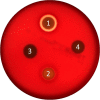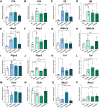Comprehensive probiogenomics analysis of the commensal Escherichia coli CEC15 as a potential probiotic strain
- PMID: 38008714
- PMCID: PMC10680302
- DOI: 10.1186/s12866-023-03112-4
Comprehensive probiogenomics analysis of the commensal Escherichia coli CEC15 as a potential probiotic strain
Abstract
Background: Probiotics have gained attention for their potential maintaining gut and immune homeostasis. They have been found to confer protection against pathogen colonization, possess immunomodulatory effects, enhance gut barrier functionality, and mitigate inflammation. However, a thorough understanding of the unique mechanisms of effects triggered by individual strains is necessary to optimize their therapeutic efficacy. Probiogenomics, involving high-throughput techniques, can help identify uncharacterized strains and aid in the rational selection of new probiotics. This study evaluates the potential of the Escherichia coli CEC15 strain as a probiotic through in silico, in vitro, and in vivo analyses, comparing it to the well-known probiotic reference E. coli Nissle 1917. Genomic analysis was conducted to identify traits with potential beneficial activity and to assess the safety of each strain (genomic islands, bacteriocin production, antibiotic resistance, production of proteins involved in host homeostasis, and proteins with adhesive properties). In vitro studies assessed survival in gastrointestinal simulated conditions and adhesion to cultured human intestinal cells. Safety was evaluated in BALB/c mice, monitoring the impact of E. coli consumption on clinical signs, intestinal architecture, intestinal permeability, and fecal microbiota. Additionally, the protective effects of both strains were assessed in a murine model of 5-FU-induced mucositis.
Results: CEC15 mitigates inflammation, reinforces intestinal barrier, and modulates intestinal microbiota. In silico analysis revealed fewer pathogenicity-related traits in CEC15, when compared to Nissle 1917, with fewer toxin-associated genes and no gene suggesting the production of colibactin (a genotoxic agent). Most predicted antibiotic-resistance genes were neither associated with actual resistance, nor with transposable elements. The genome of CEC15 strain encodes proteins related to stress tolerance and to adhesion, in line with its better survival during digestion and higher adhesion to intestinal cells, when compared to Nissle 1917. Moreover, CEC15 exhibited beneficial effects on mice and their intestinal microbiota, both in healthy animals and against 5FU-induced intestinal mucositis.
Conclusions: These findings suggest that the CEC15 strain holds promise as a probiotic, as it could modulate the intestinal microbiota, providing immunomodulatory and anti-inflammatory effects, and reinforcing the intestinal barrier. These findings may have implications for the treatment of gastrointestinal disorders, particularly some forms of diarrhea.
Keywords: Escherichia coli CEC15; Escherichia coli Nissle 1917; Gastrointestinal tract; Genomics; Immunomodulation; Mucositis; Probiogenomics; Probiotics.
© 2023. The Author(s).
Conflict of interest statement
The authors declare no competing interests.
Figures









References
-
- Hill C, Guarner F, Reid G, Gibson GR, Merenstein DJ, Pot B, et al. Expert consensus document. The International Scientific Association for Probiotics and Prebiotics consensus statement on the scope and appropriate use of the term probiotic. Nat Rev Gastroenterol Hepatol. 2014;11:506–514. doi: 10.1038/nrgastro.2014.66. - DOI - PubMed
Publication types
MeSH terms
Substances
LinkOut - more resources
Full Text Sources

